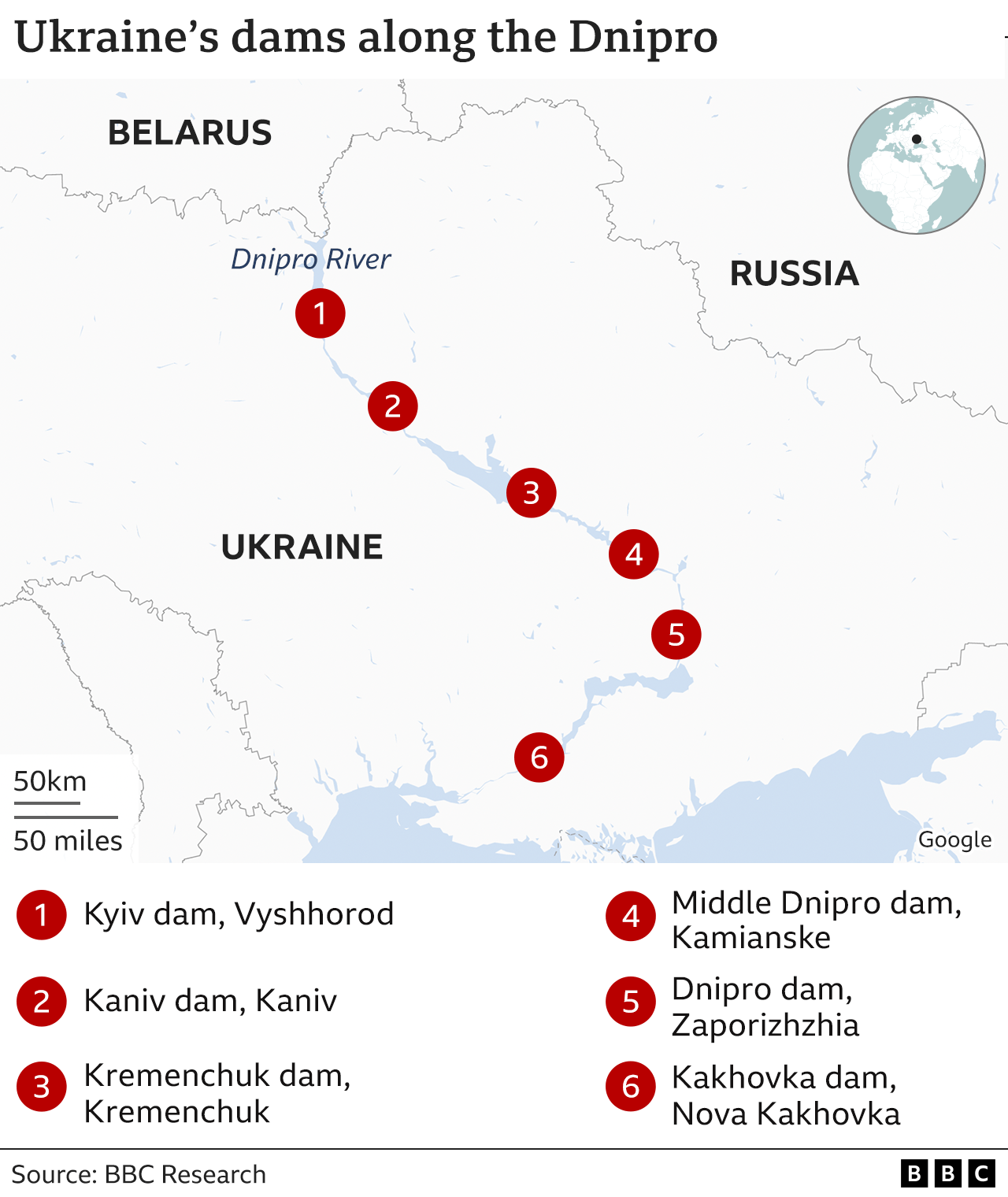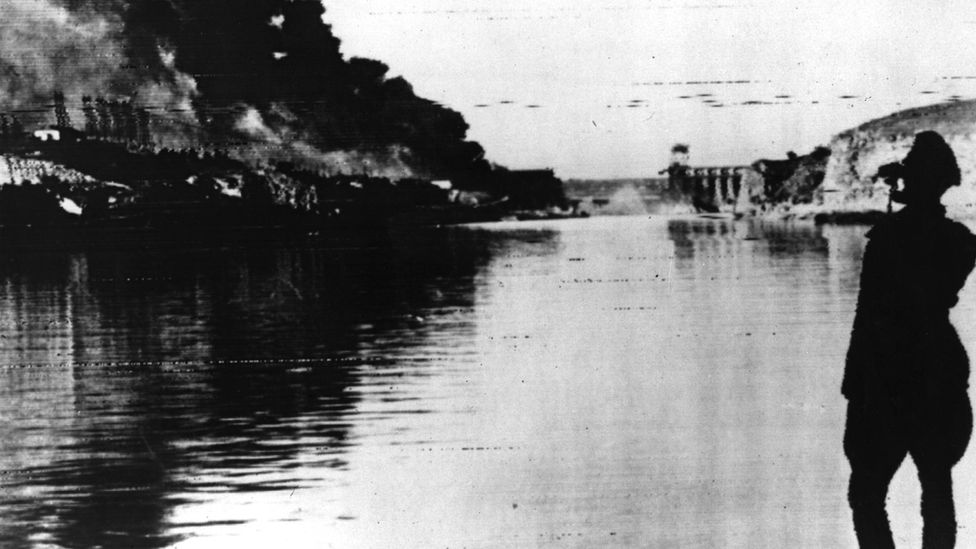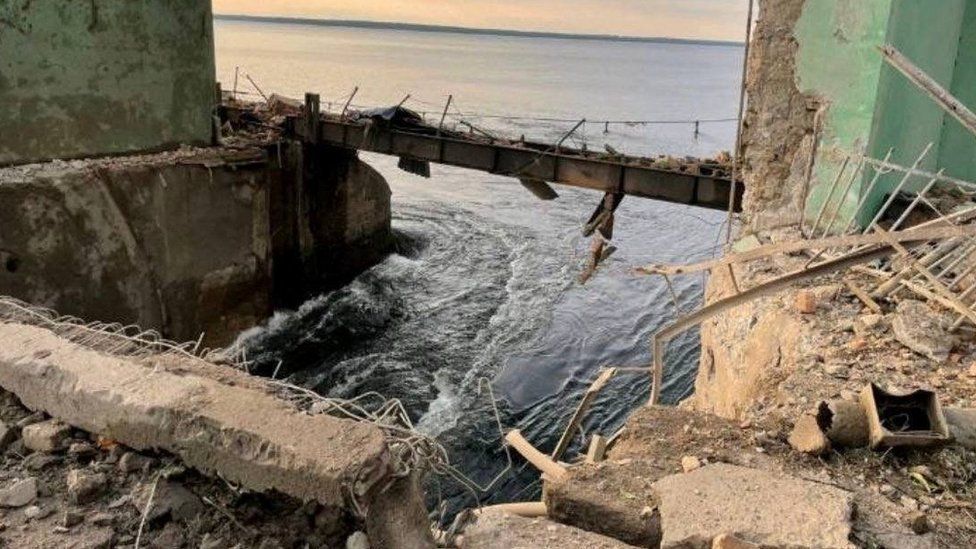
The damaged Kakhovka dam as seen in a satellite image
Ukraine has accused Russian forces of blowing up a major dam in the Kherson region, in the south of the country. The Russian authorities have accused Ukraine of shelling it.
The destruction of the Kakhovka dam on 6 June affected hundreds of thousands of people, with drinking water supplies threatened and agricultural land deluged.
Ukraine says Russia has attacked a number of other major dams, and has recently destroyed a small dam in Luhansk, in the south-east of the country.
How many dams does Ukraine have and what are they for?
In the Soviet era, engineers built a series of six dams along the Ukrainian part of the Dnipro river, which stretches from its border with Belarus 680 miles (1,095km) south to the sea.
The Kakhovka dam is the last one in the chain.

In between the dams, they turned the river into a series of huge reservoirs to provide water for households and industry, and to irrigate farmland.
Each of the dams along the Dnipro contains a hydroelectric power plant (HPP).
There are HPP dams on other rivers, and smaller dams at the entrances to reservoirs elsewhere in the country.
Before the Russian invasion, up to 10% of Ukraine's energy needs came from hydroelectric power.
How many of Ukraine's dams have been attacked?
In addition to the recent breaching of the Kakhovka dam, there have been a number of attacks on dams and power plants in Ukraine following Russia's invasion in February 2022.
In September 2022, a dam near the city of Kryvyi Rih was hit in a suspected missile attack. Ukraine blamed Russia for this
In October 2022, there were reports of missile attacks on hydroelectric dams at Kremenchuk and on the Dniester river, for which Ukraine blamed Russia
In November 2022, there was an explosion at the Kakhovka dam, for which Ukraine and Russia blamed each other
In December 2022 and February 2023, the Dnipro HPP, near Zaporizhzhia, was reported to have been attacked. Ukraine blamed Russia
In May 2023, Russian attacks "destroyed" a reservoir near Donetsk, according to the Ukrainians
In June 2023, Russian forces destroyed a dam on the Mokri Yaly river near Novodarivka in Luhansk, according to Ukraine
Some experts believe the targeting of hydroelectric dams has been part of a broader attempt to weaken Ukraine's critical infrastructure, as the war drags on.
 IMAGE SOURCE,UNIANImage caption,
IMAGE SOURCE,UNIANImage caption,The Dnipro hydroelectric power plant has been hit more than once
"This is part of Russia's strategy of destroying Ukraine's energy capacity," says Dr Marina Miron, researcher in defence studies at King's College London.
"Its hydroelectric power plants used to generate just over 6,000 megawatts of power. Following the attacks on the hydroelectric plants, some 2,500 megawatts of capacity have gone."
Following the recent destruction of the Mokri Yaly dam, Ukrainian armed forces spokesman Valeriy Shershen said that Russian forces have been deliberately blowing up dams to halt Ukraine's advance towards Russian-occupied areas.
Have Ukraine's dams been attacked before?
There's a historical precedent for incidents involving dams in Ukraine, dating back to World War Two.
In August 1941, the Soviet army was retreating rapidly as the German army advanced eastwards.
 IMAGE SOURCE,GETTY IMAGESImage caption,
IMAGE SOURCE,GETTY IMAGESImage caption,The Soviet army destroyed the dam across the Dnipro at Zaporizhzhia in 1941
Soviet commanders decided to destroy the bridges and dam at Zaporizhzhia in southern Ukraine to prevent German forces from crossing the Dnipro river and slow their advance.
Civilians were not warned, and historians estimate at least 3,000 people died as a result.
Is it a war crime to attack dams?
The Geneva Conventions and their protocols explicitly ban war-time attacks on "installations containing dangerous forces" such as dams.
 IMAGE SOURCE,REUTERS
IMAGE SOURCE,REUTERSThey are civilian infrastructure and generally not valid military targets, says Professor Tracey German at King's College, London.
"In the law of armed conflict, let's say there was a Ukrainian military unit based around a dam. Then, Russia could treat it as a military target. But as far as I am aware, that has not been the case."
"An attack on a civilian target like a dam has to be done out of military necessity," says Dr Mark Ellis, executive director of the International Bar Association.
"But if the military advantage gained is small, and the damage done to civilians is catastrophic, then that would be a violation of international law."
No comments:
Post a Comment